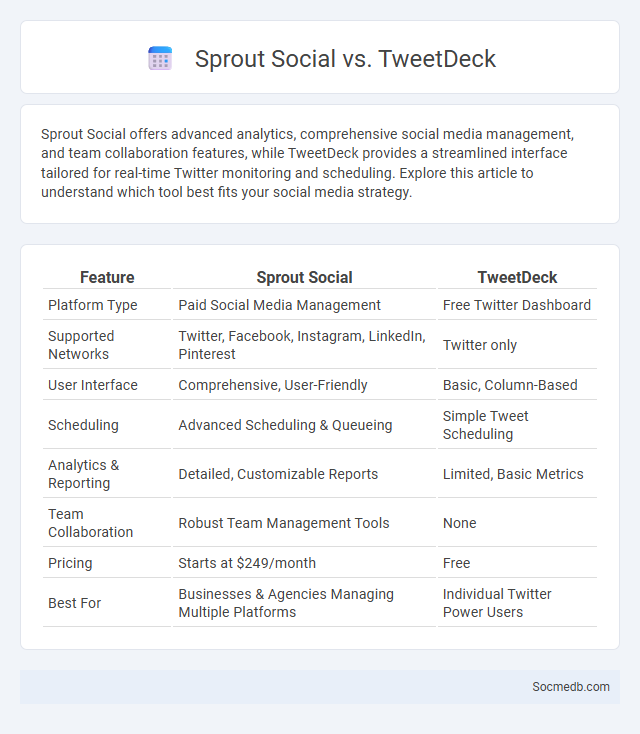
Photo illustration: Sprout Social vs TweetDeck
Sprout Social offers advanced analytics, comprehensive social media management, and team collaboration features, while TweetDeck provides a streamlined interface tailored for real-time Twitter monitoring and scheduling. Explore this article to understand which tool best fits your social media strategy.
Table of Comparison
| Feature | Sprout Social | TweetDeck |
|---|---|---|
| Platform Type | Paid Social Media Management | Free Twitter Dashboard |
| Supported Networks | Twitter, Facebook, Instagram, LinkedIn, Pinterest | Twitter only |
| User Interface | Comprehensive, User-Friendly | Basic, Column-Based |
| Scheduling | Advanced Scheduling & Queueing | Simple Tweet Scheduling |
| Analytics & Reporting | Detailed, Customizable Reports | Limited, Basic Metrics |
| Team Collaboration | Robust Team Management Tools | None |
| Pricing | Starts at $249/month | Free |
| Best For | Businesses & Agencies Managing Multiple Platforms | Individual Twitter Power Users |
Overview of Social Media Management Tools
Social media management tools streamline content scheduling, audience engagement, and performance analytics, helping you optimize your online presence effectively. Platforms like Hootsuite, Buffer, and Sprout Social offer customizable features for post automation, multi-platform management, and in-depth reporting. Utilizing these tools, you can enhance brand consistency and monitor real-time social media metrics to refine your marketing strategy.
Sprout Social: Key Features and Benefits
Sprout Social offers powerful social media management tools including scheduling, analytics, and customer engagement features designed to streamline workflows for businesses. Its advanced reporting and social listening capabilities enable data-driven decision-making and enhance brand awareness. The platform supports multi-channel publishing, team collaboration, and CRM integration, improving efficiency and boosting overall social media performance.
TweetDeck: Core Functionalities and Advantages
TweetDeck offers a streamlined interface for managing multiple Twitter accounts simultaneously, enabling real-time tracking of tweets, mentions, direct messages, and hashtags. Its customizable columns allow users to organize content efficiently, enhancing engagement and monitoring capabilities. Integration with Twitter's API ensures seamless updates and automated scheduling, making it an essential tool for social media managers and marketers aiming to optimize Twitter workflows.
Social Listening: Definition and Importance
Social listening involves monitoring and analyzing conversations, trends, and sentiment about your brand or industry across social media platforms to gain valuable insights. It helps you understand customer needs, spot emerging trends, and manage your brand reputation proactively. Utilizing social listening tools enables your business to engage effectively with the audience and make data-driven decisions.
Sprout Social vs TweetDeck: Feature Comparison
Sprout Social offers comprehensive social media management with advanced analytics, multi-platform scheduling, and customer engagement tools, providing a robust solution for businesses managing multiple channels. TweetDeck specializes in real-time Twitter monitoring and scheduling, featuring customizable columns and instant interaction capabilities ideal for focused Twitter users. Your choice depends on whether you need broad social media management with detailed reporting (Sprout Social) or a streamlined Twitter-focused tool (TweetDeck).
Integrating Social Listening into Your Strategy
Integrating social listening into your social media strategy enables real-time monitoring of brand mentions, customer sentiment, and emerging trends across platforms like Twitter, Instagram, and Facebook. Leveraging tools such as Hootsuite Insights, Brandwatch, and Sprout Social provides actionable data that enhances content relevance, boosts engagement, and informs crisis management. This approach drives informed decision-making by capturing audience needs and competitor activity, optimizing marketing ROI.
User Experience: Interface and Ease of Use
Social media platforms prioritize intuitive interfaces to enhance your user experience, ensuring seamless navigation and quick access to essential features. Simplified layouts and responsive design elements reduce friction, enabling users to effortlessly engage with content and connect with others. Consistent updates focus on optimizing ease of use, promoting prolonged interaction and satisfaction across devices.
Pricing and Value for Money
Social media platforms offer diverse pricing models ranging from free basic access to premium subscriptions and advertising packages, tailored to varying business needs and individual users. Value for money is often assessed through features like audience targeting, engagement analytics, and content promotion effectiveness, which help maximize ROI for advertisers. Selecting the right platform depends on cost efficiency balanced with the quality and reach of marketing tools available.
Best Use Cases for Each Platform
Facebook excels in community building and event promotion, making it ideal for businesses targeting broad demographics and local audiences. Instagram's visual-centric design boosts brand storytelling and influencer marketing, perfect for fashion, lifestyle, and creative industries. LinkedIn offers unparalleled opportunities for B2B networking, industry thought leadership, and professional recruitment, enhancing Your career or business growth.
Choosing the Right Tool: Sprout Social, TweetDeck, or Dedicated Social Listening
Sprout Social offers comprehensive social media management with advanced scheduling, analytics, and team collaboration features, ideal for businesses seeking an all-in-one platform. TweetDeck provides a streamlined, real-time Twitter dashboard designed for monitoring, scheduling, and engaging with tweets, perfect for users focused primarily on Twitter activity. Dedicated social listening tools like Brandwatch specialize in tracking brand sentiment, competitor analysis, and trend identification, catering to companies prioritizing in-depth audience insights and reputation management.
 socmedb.com
socmedb.com